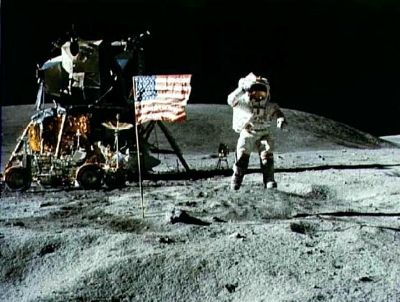Anatellô
Monthly Archive
Innovation Mindstates : Unleash Hidden Resources with a Compelling Innovation Vision.

In 1961 John F Kennedy, set forth his vision for the United States to put a man on the moon within the decade.
At the time, none of the powerful rocket engine and computing technologies required to fulfil his ambition existed. Nevertheless, nine years later his vision had become reality.
By the very fact of sharing and committing to his bold vision, JFK was mobilising huge resources towards his innovation project. These resources include the creativity and enthusiasm of all the team members at NASA and all the other science, technology and engineering bodies who could play a part in delivering JFK’s vision.
Without taking the bold step of sharing his ambitious vision, these resources would not have been available to the project to the same extent, if at all.
The Neuro Linguistic Programming (NLP) community would say it is about focus. You get what you focus on. If you focus on your dreams and great things you want to happen, you’ll move towards them. If you focus on problems and ‘bad stuff’ you’ll move towards them.
Nowadays, when resources for innovation projects are often tightly constrained, can innovation project leaders learn from this? Could they do as JFK did and commit to a grand vision and thereby attract the commitment, motivation and enthusiasm of their teams that could drive the project forward?
Fear of Failure.
Of course in competitive organisational cultures, it can feel risky to commit to a bold vision.
So much easier to be cautious and focus on incremental innovations. Then, if you fail to achieve them, you and your reputation do not fall so far.
So it was good to hear recently of someone else going public on a grand vision. Sir Richard Branson , a man famous for his vision, is now looking to develop supersonic air travel that will enable travel from New York to Tokyo in less than an hour. Of course, he’ll be busy with his Virgin Galactic flight programme first, but after that...
Just like JFK, Branson, in sharing his vision, of itself, will unleash some of what is needed to make the vision actually happen.
To see how this has worked for him in the development of Virgin Galactic, check out this video.
Leading and Following an Innovation Vision.
Of course, if your organisation wants to mobilise around a compelling innovation vision there will need to be someone or a group of people who can conceive of such a vision and bring it to life. There will also need to be others who follow that vision.
If there isn’t a leader with a vision and followers of the vision, then you cannot tap into the resources in the same way.
Kodak : For Want of Vision?
In 1975 Kodak discovered the digital camera. However, in 2012 Kodak filed for chapter 11 bankruptcy. It seems that nobody at Kodak had been able to envision a new world where people didn’t put films in their cameras, a world where Kodak’s expertise in camera film would no longer be widely relevant.
Therefore Kodak did not allocate resources to the digital camera and bring it into production. In time competitors did, and Kodak’s revenues from film plummeted.
If someone at Kodak had been able to envision the future digital world back in 1975, they would have been better placed to bring the digital camera to market, ahead of the field. They would have had first mover advantage and be able to gain more and more expertise about the technology and push even further ahead.
Or maybe there was someone with that vision... but they were not able to communicate it in a way to motivate people to follow it.
Innovation leaders and innovation followers both have a part to play.
So, how can innovation leaders capitalise on the power of innovation vision?
Tips for Innovation Leaders and Followers
Innovation Leader
( not necessarily the CEO you may just be a project manager leading an innovation project)
- Set a bold vision for your innovation
- Bring that vision to life for self and others – make it compelling through visualisation, add lots of sensory information. What will that future world - where your vision is realised - be like? What kind of things are people saying, doing?
- Create collages or digital pinboards to represent that time when your vision is achieved.
- Revisit that innovation vision on a regular basis – even when things aren’t going well... Especially when things are not going well!
Innovation Followers.
- Engage wholeheartedly with the innovation leaders’ vision.
- Ask yourself “How can I contribute to this?”
- You may have concerns but make sure you balance your negative and positive energy, so that you don’t become a drag on the project.
- Raise concerns at appropriate times – but remember to stay open-minded to situations that are beyond any previous experience you have had.
- If you feel anxious about what lies ahead – try reframing your feelings as... excitement.
© Anatellô Ltd 2014. All rights reserved.
Picture courtesy publicdomainimages.com



